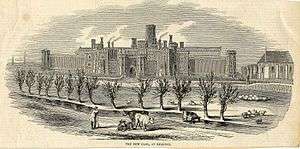HM Prison Reading
|
| |
| Location | Reading, Berkshire |
|---|---|
| Security class | Young offenders Institution |
| Opened | 1844 |
| Closed | 2013 |
| Managed by | HM Prison Services |
| Governor | Darren Hughes |
| Website | Reading at justice.gov.uk |
HM Prison Reading, formerly known as Reading Gaol, is a former prison located in Reading, Berkshire, England. The prison was operated by Her Majesty's Prison Service until its closure at the end of 2013. It is a Grade II-listed building.[1]
History

HM Prison Reading was built in 1844 as the Berkshire County Gaol in the heart of Reading, Berkshire on the site of the former county prison, alongside the site of Reading Abbey and beside the River Kennet.
Designed by George Gilbert Scott it was based on London's New Model Prison at Pentonville with a cruciform shape, and is a good example of early Victorian prison architecture. The Pentonville Prison design of 1842 was based on the design of Eastern State Penitentiary of 1829 in Philadelphia, Pennsylvania.
It was designed to carry out what was the very latest penal technique of the time, known as the separate system. As a county gaol, its forecourt served as the site for public executions, the first one in 1845 before a crowd of 10,000; after 1868 executions took place inside, the last one in 1913.
It was used to hold Irish prisoners involved in the 1916 Easter Rising, for internment in both World Wars, as a Borstal and for a variety of other purposes. Most of those interned during the First World War were of German origin but there were also Latin Americans, Belgians, and Hungarians. In 1969 the wing where the Irish had been held was demolished.[2]
In 1973 Reading was re-designated as a local prison and around that time its old castle wall was removed. In 1992 it became a Remand Centre and Young Offenders Institution, holding prisoners between the ages of 18 and 21 years.
Before closure, Reading was a young-offender institution and remand centre, holding males aged 18 to 21. Accommodation at the prison consisted of a mixture of single and double occupancy cells contained on three wings. There was also a further residential unit (Kennet wing) of single occupancy cells for low security 'open' prisoners. There were two education departments at Reading prison, one run by the Prison service and one by Milton Keynes College. The remand centre library was run by Reading Borough Libraries.
On 4 September 2013, it was announced that HM Prison Reading would close by the end of that year,[3] and the prison formally closed in November.
There have been calls for the prison building to be preserved as a tourist attraction, and Reading Council have confirmed that they intend to retain the complex.[4] In June 2014 it was proposed that the site could be converted into a theatre venue.[5] However, in November 2015 it was announced by Chancellor George Osborne and Justice Secretary Michael Gove that the site was to be sold to housing developers.[6]
In May 2016 it was announced that the former prison would be made available as an arts venue for the Reading 2016 Year of Culture programme.[7]
Notable former inmates
- Oscar Wilde - author of poem The Ballad of Reading Gaol based on memory of an execution that took place here while he was serving a sentence for homosexual offences.
- Charles Thomas Wooldridge - murderer, whose execution inspired Wilde's poem.
- Stacy Keach - actor, served 6 months here after being arrested for cocaine smuggling in 1984
- Amelia Dyer - serial killer
References
- ↑ "Reading Prison of Oscar Wilde fame closes early". BBC News.
- ↑ http://www.berkshirerecordoffice.org.uk/albums/enemies-of-the-state/reading-prison/
- ↑ David Millward. "Ministry of Justice announces closure of Reading Prison - Reading Post". Getreading.co.uk. Retrieved 2013-09-05.
- ↑ "BBC News - Call to save 'Oscar Wilde jail' in Reading". Bbc.co.uk. 2010-09-24. Retrieved 2013-09-05.
- ↑ "BBC News - Reading jail considered as site for new theatre". Bbc.co.uk. 2014-06-05. Retrieved 2014-07-22.
- ↑ "Prison building revolution announced by Chancellor and Justice Secretary". www.gov.uk. 2015-11-09. Retrieved 2016-02-10.
- ↑ "HMP Reading set to be Year of Culture venue". BBC News. 2016-05-25. Retrieved 2016-05-26.
Bibliography
- Peter Southerton: Reading Gaol by Reading Town (Berkshire Books, Gloucs., 1993).
- Anthony Stokes: " Pit of Shame, The Real Ballad of Reading Gaol " (Waterside Press, 2007).
External links
- Ministry of Justice pages on Reading
- Ballad of Reading Gaol Etext
- Essay on Wilde and the history of Reading Prison
Coordinates: 51°27′23″N 0°57′51″W / 51.45639°N 0.96417°W
